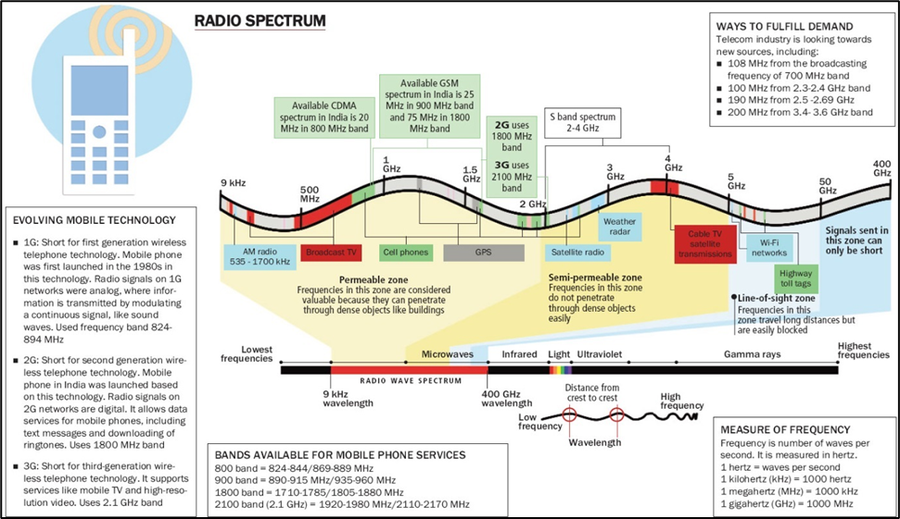Why in news?
Speaking on the sidelines of the India Mobile Congress, Telecom minister said that satcom spectrum will be allocated administratively but will come at a cost.
As per the announcement, the cost of spectrum and the formula of allocation will be decided by the Telecom Regulatory Authority of India (TRAI).
What’s in today’s article?
- Airwaves/Spectrum
- Satellite spectrum
- Auction vs administrative allocation of spectrum
- Satellite spectrum to be allocated administratively in India
- Spectrum allocation controversies in India
Airwaves/Spectrum
- Airwaves are radio frequencies within the electromagnetic spectrum that can carry information wirelessly for a range of services including telecommunications.
- The government manages and allocates airwaves to companies or sectors for their use.
- The government auctions a fixed amount of spectrum within specified band/s to be utilised by operators for providing communication services to consumers.

Satellite spectrum
- About
- Satellite spectrum refers to the range of radio frequencies used by satellites to communicate with ground stations, other satellites, and various devices on Earth.
- These frequencies are part of the electromagnetic spectrum, specifically the radio waves, and are allocated for different satellite services, such as communication, broadcasting, navigation, and Earth observation.
- Regulation
- The use of satellite spectrum is regulated by international bodies like the International Telecommunication Union (ITU).
- ITU coordinates and allocates frequencies to prevent interference between different satellite systems and other forms of communication.
- Satellite Frequency Bands
- L-band (1-2 GHz): Used for GPS and mobile satellite services.
- S-band (2-4 GHz): Used for weather radar, air traffic control, and mobile satellite services.
- C-band (4-8 GHz): Commonly used for satellite TV broadcasting and data communications.
- X-band (8-12 GHz): Used primarily by the military for radar and communication.
- Ku-band (12-18 GHz) and Ka-band (26-40 GHz): Used for satellite television, internet, and high-throughput data transmission.
Auction vs administrative allocation of spectrum
- Auction
- Auctions involve competitive bidding, where spectrum licenses are sold to the highest bidder, promoting efficient resource allocation and generating revenue for the government.
- This method ensures transparency, reducing the chances of favoritism or corruption, and is commonly used in commercial telecommunications for optimal spectrum usage.
- Auctions are preferred in competitive markets where multiple entities compete for access.
- Administrative allocation
- Administrative allocation involves the government directly assigning spectrum licenses without a bidding process, often for a nominal fee covering administrative costs.
- This method is used when auctions are impractical, offering flexibility for sectors like national security, public services, or emerging industries like satellite communications.
- It is suitable for areas with low competition or where frequency sharing among users is feasible, ensuring easier access to resources for specialized or government-related services.
- Key differences between auction and administrative allocation
- The auction method is competitive, market-driven, and generates significant revenue, ensuring transparency by allocating spectrum to the highest bidder, making it ideal for commercial markets.
- In contrast, administrative allocation is a direct government assignment with lower fees, offering flexibility but less transparency, suited for government services or specialized sectors.
- Both methods are essential in spectrum management, with the choice depending on regulatory goals and market needs.
Satellite spectrum to be allocated administratively in India
- About the news
- The government has chosen to allocate satellite communication (satcom) spectrum through administrative means, rejecting the auction route.
- This development underscores the growing competition for satellite services in the Indian market, which is projected to grow at 36 per cent annually and reach $1.9 billion by 2030.
- Starlink, Musk’s company, advocates for direct licensing, aligning with global practices and arguing that spectrum, as a natural resource, should be shared.
- On the other hand, Reliance, led by Ambani, believes that an auction is necessary to ensure fair competition.
- Rationale behind India’s stand
- Unlike terrestrial spectrum which is used for mobile communications, satellite spectrum has no national territorial limits and is international in character.
- Satellite spectrum is shared spectrum. If the spectrum is shared, then it cannot be priced individually.
- As a result, satellite spectrum across the world is allocated administratively.
- India, being a signatory of ITU, decided to follow the global practice of allocating satellite spectrum administratively.
- The Telecommunications Act, 2023, had also added spectrum for satellite communication in the list of administrative allocation.
Spectrum allocation controversies in India
- India’s spectrum allocation has been controversial, especially due to the shift from auctions to administrative assignments, highlighted by the 2G spectrum scam.
- The scam involved allocating licenses on a first-come, first-served basis, resulting in significant financial losses, with alleged damages of Rs 30,984 crore and a presumptive loss of Rs 1.76 trillion.
- Following this, the Supreme Court mandated auctions for spectrum allocation in 2012.
- Despite this, the Telecommunications Act 2023 introduced a non-auction route for allocating satellite spectrum, marking a shift in the regulatory approach.










